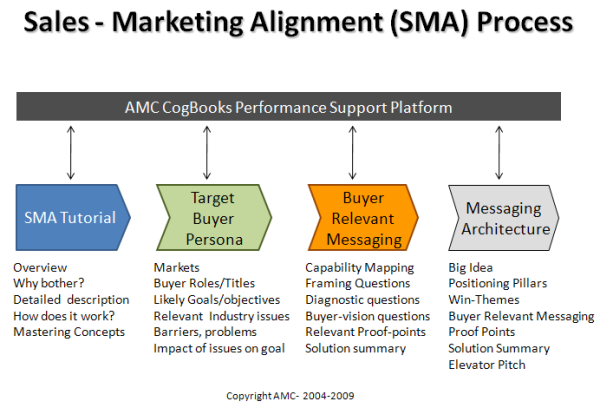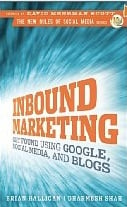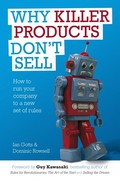Introducing new high technology and green technology products or services or getting an acquired company’ products sold through an existing sales team is a challenge for entrepreneurs in early stage companies and sales and marketing leaders in more mature companies.
We have had both as clients, however I’m always astonished to see smart people doing really dumb things with their own and their investor’s money. There are a few telltale signs of a struggle going on inside an organisation. This is a struggle to find new prospects and to improve sales and marketing performance, accompanied by lots of hand-wringing and pointing blaming fingers at each other.
The first clue that there are problems is the corporate Web-site. The company’s Website, which is without a doubt the company’s most valuable asset (after its people), very often looks like it has been written by the product management team. Often densely packed, with no white space; or sparse with nothing to engage the accidental visitor other than “product-speak”= meaningless features and benefits and gobbledygook. Pay-per-click is used to generate inbound leads and is fast burning investors cash.
The second clue, is that the sales team is tasked with making cold-calls to generate their own leads; and the company is wasting money on external telesales teams to generate appointments that hardly ever convert. We are marketing and selling in the Internet age and in 2009, buyers don’t want cold calls and junk email from suppliers to introduce them to their latest widget….yet strangely we see telemarketing companies thriving and a die-hard group of cold calling sales trainers and promoters who are championing an obsolete way of doing business.
I believe that in all high-tech and green-tech companies, sales and marketing should be united and aligned under one leader. A sale starts with an inbound visitor and it’s the role of marketers to generate inbound visitors that convert into leads. Sales and marketing teams need a universal way of defining leads and engaging prospects around their buyer-persona; one language from the Website to the sales person's lips that engages buyers around how their products or services are used by their customers to create value; the messaging reinforced by high value video testimonials, keyword rich blogs, case studies, Webinars and sector relevant white papers and E-books that pull in prospects.
4 min read
Create Differentiated Value with Inbound Marketing
By Mark Gibson on Wed, Oct 21, 2009
Topics: inbound marketing differentiation value creation
3 min read
Inbound Marketing - A Book Review
By Mark Gibson on Mon, Oct 19, 2009
As Hubspot customers, Hubspot partners and fellow travelers on the inbound marketing journey for 10 months now, we heartily recommend "Inbound Marketing", by Dharmesh Shah and Brian Halligan, as this book represents a very readable and do-able playbook for implementing inbound marketing methodology.
Packed with concise guidance, case studies, and practical to-do’s that you can implement today, this book is really a text-book on the subject and is one of the most important books for Internet era marketers published to date.
Topics: inbound marketing hubspot book review
3 min read
Are Marketing People Needed in Selling SaaS Solutions?
By Mark Gibson on Wed, Oct 14, 2009
This is the second part of an article Are Sales People needed in Selling SaaS solutions written in response to conversations with three entrepreneurs who have created, or are creating SaaS solutions to serve very specific needs for a well-defined market opportunity. In conversation it emerged that none of them were planning on having any sales people in their business.
Topics: inbound marketing Saas
4 min read
Are Salespeople Needed in Selling SaaS Solutions?
By Mark Gibson on Tue, Oct 13, 2009
The thinking here is that since the products are so strong and the market need exists, by offering a free trial, the prospect will learn to use and love the product and convert into a customer; all without needing a human touch. Who needs sales people anyway?
This approach is similar to the "Field of Dreams" (if you build it, they will come) strategy; popular with entrepreneurs who are long on product engineering skills but underestimate the importance of marketing and selling in the lifecycle of successful products. This attitude has led to the premature death of many killer-products.
Now let me say here that I would not advocate putting a salesperson in the way of a buyer who was motivated to buy and did not require interaction with a salesperson. Dell recognized this desire early on and enabled people to self-serve PC’s and Laptops nearly ten years ago and cut billions out of their cost of sale. Dell had a couple of things going for it that early stage SaaS companies don’t; - brand equity and market dominance in a mature buying category.
Killer-products, and especially software products don’t sell themselves unless they fulfill the following criteria
- A mature, clearly defined buying category exists,
- Market demand exists for the products/services,
- Acquisition is as simple as buying a book on Amazon,
- Implementing the products is seen as risk-free and the vendor is trusted,
- The products are easy to use, learn and deploy,
- The buyer knows what they want and it's really a matter of what color and how many.
- The market price is established and the vendor offerings are within an acceptable range.
Topics: inbound marketing Saas value creation
7 min read
Recruiting SaaS B2B Sales Channels and Getting Sell-through
By Mark Gibson on Wed, Sep 09, 2009
This is a hot topic - not only for the new cohort of SaaS solutions providers, but for every entrepreneur with visions of channel sales success as well as medium sized companies wanting to sell innovative products through an indirect model.
Why Channel Sales?
The fundamental question is - why do you want to sell through channels?Let’s assume you have some really strong business reasons for wanting to sell through the channel and everyone in your company, including the investors, is on board with the idea.
Before proceeding, please ask yourself the following four questions.
- Is your direct sales process fully optimized, to the point that you have identified your own best practices and everyone on the direct sales team sells the same way?
- Are you generating more inbound leads than you can handle meaning sales people spend all of their time speaking to interested prospects (inbound leads) who find you on the Internet -and are not cold calling or working on telesales developed leads?
- Is your product fully-baked, to the point where the code is stable, you have an SDK, standards-based API and fully documented instructions on how to extend and integrate with your product?
- Are your existing customers raving fans of your product?
Based on this experience I suggest that if the answer to all four questions above is not a resounding “yes”, then you are probably not ready to sell through channels. I coined the phrase “when you are truly ready, the channel will show up”, based on years of direct work with and observation of how the vast majority of channel partnerships actually work.
Trying to move channel partners in a specific direction before either they, you, or more importantly, the market is ready, inevitably leads to wasted effort, cash and disappointment.
Now let’s assume you already have a committed channels plan in place, you have dedicated resources and a number of channels partners signed up, and like thousands of companies worldwide - your program stinks.
When I speak with CEO’s, they routinely point to weak channels as their number two problem in their B2B sales and marketing groups, right behind the top problem of insufficient qualified leads.
So how do we come to grips with the harsh realities of today’s market, the overall capabilities of channel partners and what we should really expect from them? The remainder of this post will provide some insights and recommended tools that you can use to actually improve channel performance:
Selling to the early market
First and foremost, is your product, service or solution based on a novel or discontinuous technology? If not, is it an evolution of an existing product or technology in an established market? The answer to this question is crucial.
• If your product is novel and truly disruptive, go back and answer the first four questions.
• Now that you have answered the questions again in your own mind, is there an established buying category and have your products been accepted by the early majority (mainstream market) or are you still selling to the early adopter market and trying to get across the chasm?
- If you are across the chasm and into the early majority, please go to the next question
- If you are selling to the early market then you will need your channel to sell the way the early market wants to buy. The early market buys differently from the mainstream market and it is a "value-created" or consultative sell.
- The "Technology Adoption Cycle vs. Risk" animation is adapted from our Selling in the Internet Age training course IMPACT Buying Concept.
- Most channels sales teams are geared for "value-offered" or "value-added" sales models and simply don’t understand how to, or have the skills to sell novel technology to early adopters.
- This mismatch in the early market "value-created" buying culture vs. the way the typical channel partner is selling (value-offered or value-added) is the biggest reason why so many channel partners and programs fail. Follow this link to a discussion on why value-created selling is key to penetrating the early market. You might want to have a discussion with your direct sales team on this topic as well and buy a few copies of the book Why Killer Products Don't Sell.
Selling to the Mainstream Market
If you’ve made it and sold your way across the chasm, congratulations are in order as this is a fantastic achievement for any business. If you're positioning a new product in an established buying category, with established competitors then you face another set of interesting challenges:- How are you planning to, or how did you acquire your existing partners?
- Do they fit with where you are today and where you need to go?
- What relevant training and support have you provided for them?
- Have you developed your own Messaging to raise the standard of conversations your direct sales team has with target buyers and to differentiate your product vs. competition and, more importantly, have you trained your partners to use it in role-playing situations?
- Don’t expect the channel sales team to figure this out on their own. Most have other products in their portfolio to sell and they are probably more comfortable doing so.
- Channel sales performance is a direct result of how easy you make it for their salespeople to position and sell your product and the market demand for the product class.
- If all your channel have is a PowerPoint, brochures and a price-list parked on a portal somewhere and distant memories of a ½ day product pitch from your product management team, then you will fail.
- Have you planned to collaborate on lead generation programs and have you shared leads with them?
- Have you gone on their first half dozen sales calls to give them feedback and coaching on their sales calls?
What channels sales people need to be successful
If you plan to spend as much or more effort on training the channel to sell as you do your direct team, then this is a good equation. In the post-Internet era the value of a 1:1 call with a buyer has risen by an order of magnitude; here are a few suggestions as to what direct and channel sales people need to be successful.
- It starts with a lead and Inbound Marketing is a better way to generate leads whether you are a technology vendor or a channel partner and its 60% cheaper than alternate methods.
- Product-usage training and storytelling around the target-buyer persona, i.e. what are the roles, goals and likely issues your target buyers are having where your products could potentially help and the rationale?
- Read “New Rules of Marketing & PR”. It’s a revelation on marketing to the interests of buyers and relevant for all marketers.
- Product knowledge and how to position relevant capabilities and to diagnose and qualify if these capabilities are relevant
- d. The ability to have the buyer envision using your product and/or service in solving their problem
- e. Understanding and leading the buyer through the value-exchange in using your product and the associated ROI.
- f. Communication, language skills, sales-craft skills and tools for Selling in The Internet Age
- Big Idea narratives and visual confections that tell your story and guide conversations with target buyers, supported by proof points to create a story that engages the buyer, create true differentiation for both direct and channel salespeople
Where the channel works really well
In today’s technology market, there are many great examples of highly functional and well-developed channels. Cisco Systems, Microsoft and Salesforce.com have surrounded themselves with hundreds of thousands of partners that deliver, implement or extend their products and services with a high degree of effectiveness.This primarily occured because all three companies realised that extending their ability to reach a broader audience would best be served though a channel. Except for Microsoft, channel success ocurred after their markets were well developed and beyond the chasm, it was easy for the value-added partners to do exactly what they do best, e.g. add value.
To enjoy the highest level of success with your channel, understand what they can and can’t do for you, equip them to win and set mutual expectations. Most importantly, even though they are not your employees, treat them like they are, invest in training them like they are your own and manage them closely.
Otherwise, don’t be surprised when they fail to deliver.

Topics: inbound marketing killer products marketing messaging
1 min read
Inbound Marketing: E-Books and White Papers that engage!
By Mark Gibson on Thu, Aug 27, 2009
I'm speaking with Stephanie Tilton, marketer, writer, blogger and expert on generating inbound traffic based on the words you write in blogs, E-Books and White papers. I'm showing Stephanie in real-time how easy it is to create a blog-post on Hubspot's Inbound Marketing platform and I'm getting some free advice on writing white papers.....I hope this is of interest to you.
Topics: inbound marketing
3 min read
Inbound Marketing - a better approach to lead generation
By Mark Gibson on Tue, Jun 16, 2009
When engaged by VICO Software in 2008 on a sales and marketing messaging alignment and consultative sales training project, we had an “AH-HA” moment when it came to a discussion around marketing performance.
Topics: inbound marketing differentiation
4 min read
Are You Ready For Inbound Marketing Yet?
By Mark Gibson on Sat, Mar 28, 2009
Chances are you didn’t arrive here by accident; you followed a link from either a search engine or a Blog or links from a social network site…welcome to inbound marketing.
Topics: inbound marketing marketing messaging
2 min read
World Wide Rave reaches St Andrews, Scotland
By Mark Gibson on Fri, Mar 20, 2009
David Meerman Scott's new book World Wide Rave builds on concepts in his highly original "The New Rules of PR and Marketing" and creates a manifesto for massive inbound marketing success in marketing ideas/products/services over the Internet. Rich with anecdotes and stories from people who have created their own World Wide Rave, David inspires challenges and stimulates thinking which has profound impact for anyone selling or marketing anything.
An overnight success - 10 years in the making, David's ideas are rapidly changing the way people market products and create PR. He describes himself as a recovering marketing executive having led marketing efforts at Knight Ridder and News Edge in the old World of Marketing and PR.
Every day in the technology business I see old-World examples which David highlights - marketers wasting time, money and precious resources on doing things the old way. Buying PR services, counting print impressions, spamming people with direct mail and email campaigns; hiring telemarketers to generate leads because their me-too Websites don't have sufficient inbound lead flow to feed the sales force.
Typically these companies are product-centric; you'll see product features and benefits (another sure sign of old-World thinking) on their site and the good stuff, their interesting ideas are under lock-and-key...you have to give your contact details to get it - so they can SPAM you with email and hound you with Telemarketers.
Topics: inbound marketing book review buyer-persona
2 min read
Critical Sales and Marketing Skills and Practices
By Mark Gibson on Fri, Dec 05, 2008
There are several proven routes to improving sales and marketing effectiveness, whether in good times or recession. What is surprising is how few companies have adopted this life-cycle approach to sales and marketing excellence.









